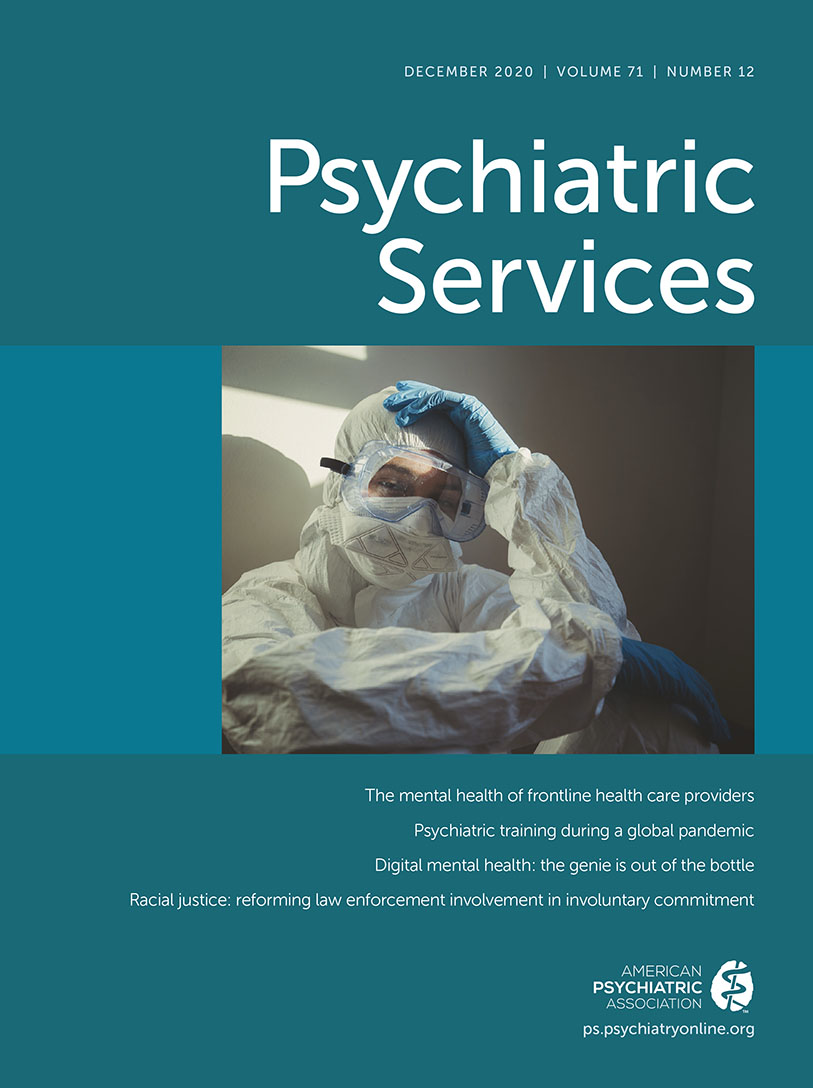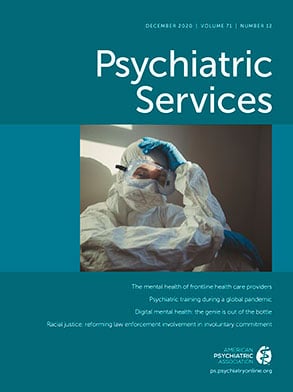As part of a comprehensive effort to prevent veteran suicide, the Veterans Health Administration (VHA) recently implemented Risk ID, a standardized national suicide risk screening and evaluation initiative (
1). Fully implemented, this process ensures that nearly every veteran receiving care in the VHA, including those who do not present with a diagnosed mental or behavioral health condition, will be screened and/or evaluated for suicide risk. Veterans with a positive initial screen, determined by response to item nine on the Patient Health Questionnaire-9, complete a second level of screening with the Columbia Suicide Severity Rating Scale (C-SSRS) Screener. The second-level screening comprises between three and eight questions, depending on the veteran’s responses. A positive secondary screen triggers the Comprehensive Suicide Risk Evaluation (CSRE). Using the Risk ID process, clinicians and patients can work together to facilitate identification of suicide risk and individualized treatment needs. Veterans at elevated risk may receive additional services, such as suicide prevention team support and evidence-based treatments aimed at addressing drivers of suicide and associated mental health conditions (e.g., depression). During the first year of implementation (October 2018–September 2019), over four million veterans in the VHA were screened in ambulatory care settings, and over 1.9 million screens occurred in the emergency department.
As noted by Warren and Smithkors (
2), those who serve veterans must remain vigilant against reactive policy making of questionable benefit and must protect against provider burnout. Doing so necessitates adoption of evidence-informed policies that promote optimal care for veterans. The cornerstone of evidence-based medicine (
3) and the goal of Risk ID is to balance the competing needs of compelling best practices in suicide risk identification and management and of affording providers the latitude to exercise clinical judgment and individual therapy styles to meet patients’ personalized needs.
By design, Risk ID exemplifies the three pillars of evidence-based medicine (
3). Specifically, standardizing suicide risk screening and evaluation on the basis of the best available evidence reduces unwanted practice variation while allowing clinicians to use their skills and expertise to gather important information to formulate clinical impressions of suicide risk that are then used to tailor interventions to patients’ needs and preferences (
3). In developing Risk ID, the best available evidence regarding suicide risk screening and assessment was reviewed by a multidisciplinary team of suicide prevention experts and stakeholders from various program offices (e.g., nursing services, primary care, mental health and suicide prevention, and emergency medicine). Concurrently, suicide prevention experts updated the U.S. Department of Veterans Affairs (VA) and Department of Defense’s Clinical Practice Guideline (CPG) for the Assessment and Management of Patients at Risk for Suicide (
4), and the Joint Commission updated the National Patient Safety Goal (NPSG) related to suicide prevention (
5). Risk ID aligns with suicide risk screening and evaluation recommendations from the CPG and relevant NPSG elements of performance (EPs) (i.e., EPs 2–4). Furthermore, in its rationale for EP3, the Joint Commission references an approach to therapeutic risk management of patients at risk for suicide, a framework developed within the VHA that was incorporated into the CSRE (
5).
Consistent with evidence-based medicine (
3), the Risk ID implementation team works closely with clinical teams across the enterprise to ensure that screening and evaluation are incorporated into existing workflows and conducted in a manner that responds to the needs of veterans. Providers completing the CSRE are encouraged to gather information about evidence-based factors contributing to suicide risk through a clinical interview. It is recommended that this be done in a manner consistent with their therapeutic style and clinical expertise, with the goal of meeting the needs and preferences of the veteran being served. To support implementation, training webinars were developed to demonstrate how to conduct the CSRE in a therapeutic and collaborative manner and allow the Veteran to share his/her narrative around suicidal thoughts and any past suicidal behavior. The clinician can then use this information to formulate clinical impressions about level of risk and risk mitigation strategies. The CSRE was intentionally designed without scripted questions to allow clinicians flexibility in how they conduct the evaluation. That is, it provides a guide for documenting the essential components of suicide risk evaluation, while the clinician captures the patient’s narrative in the context of a therapeutic relationship.
Our experience leading national implementation of Risk ID and the circulation of inaccurate information have revealed continued confusion regarding Risk ID policy requirements. For example, Warren and Smithkors (
2) state that “clinicians are now expected to complete at every initial clinical contact a standardized comprehensive evaluation for certain patients” and that the CSRE is required even when validated screening instruments have provided negative results, or when the comprehensive evaluation is “not clinically indicated.” These statements are simply erroneous. The emergency department is the only setting in which screening is required at every encounter, and no setting requires the CSRE at every encounter (
1). In all settings, with the exception of mental health residential and opioid treatment programs (which have their own accreditation requirements), the CSRE is required only when the C-SSRS screen is positive (
1).
More importantly, misconceptions about the evidence base for Risk ID and misinterpretations of program requirements undermine the clinical and scientific integrity of these policies and practices and lead to greater confusion in the field. Such confusion can inadvertently contribute to provider burnout. As noted in the literature (
6) and observed in our experiences consulting with a wide range of leaders and providers through the VHA’s Suicide Risk Management Consultation Program, clear expectations as well as concrete guidance about how to approach and document suicide risk screening and evaluation can mitigate burnout. Providers working with veterans at risk for suicide have consistently expressed the need for guidance on how to help promote the safety and well-being of their patients.
Unfortunately, the perspectives of Warren and Smithkors (
2) also reinforce the widespread yet inaccurate belief among those in health care that standardization and personalization are conflicting goals. On the contrary, we contend that standardization and personalization are
complementary approaches to improving provider practice and veteran experience of suicide risk identification and management.
Misconceptions such as these are important to attend to because they highlight challenges with implementing a population-based screening and evaluation initiative in a health care system as large and diverse as the VHA. It is imperative that efforts continue to better inform clinicians about policy requirements and to support the implementation of such requirements in a manner that honors our patients’ and providers’ experiences. The VHA has utilized evidence-based implementation strategies (
7), such as tools and training, proactive technical assistance, and the provision of quality improvement data. For example, on the basis of input and questions from frontline providers, we developed a frequently asked questions document that offers additional implementation guidance, which is presented on weekly technical assistance calls and posted on a SharePoint website. With support from the VA’s Quality Enhancement Research Initiative (QUERI) and the Office of Mental Health and Suicide Prevention (
8), our team will soon begin to offer higher levels of implementation support (i.e., audit and feedback and external facilitation) that are tailored to facility performance level. This approach ensures that facilities with the most need receive targeted evidence-based strategies to improve uptake.
Despite the challenges associated with change, we assert that change is a prerequisite to progress. The VHA has played a leading role in advancing the standard of care, especially regarding suicide risk assessment and management, with safety planning, flags to signal high-risk patients, the Veterans Crisis Line, and the Suicide Risk Management Consultation Program. Risk ID extends this list. As with any learning health care organization, evidence-informed policy should be the foundation of the VHA’s suicide prevention practices. This is especially true when the evidence makes clinical sense and reflects what is best for our patients. More importantly, as the state of evidence is constantly evolving, we must also be open to refining our approach and changing over time. Ongoing efforts to systematically evaluate implementation and the impact of policy changes on providers’ and veterans’ preferences and outcomes are essential to informing both system- and program-level improvements with the goal of reducing suicide among our nation’s veterans.

